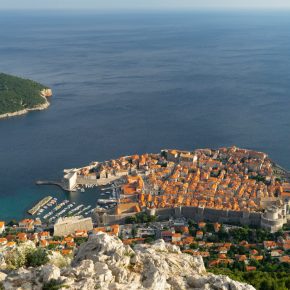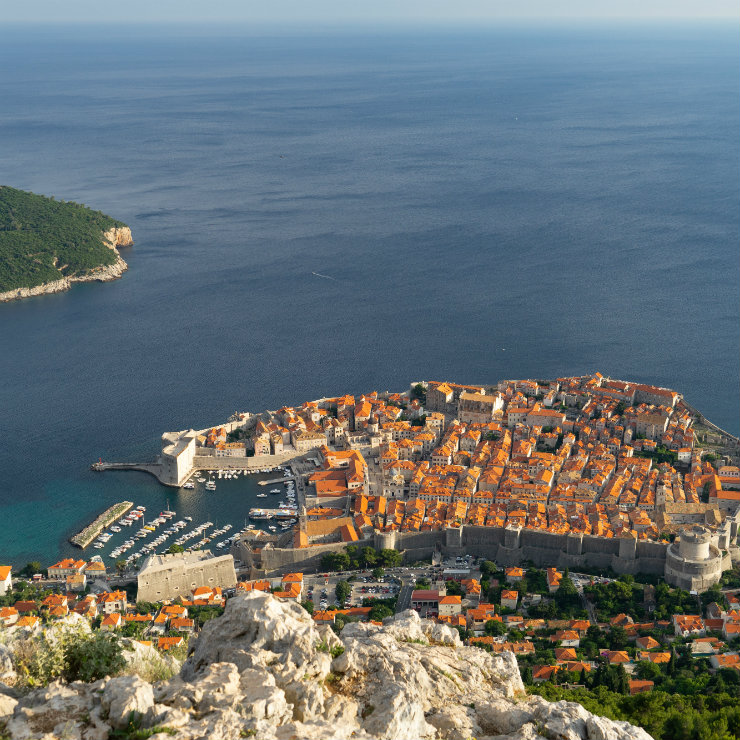
Dubrovnik, Croatia (Sei F, CC BY-SA 2.0)
Tourism in Croatia is concentrated in the areas along the Adriatic coast and is strongly seasonal, peaking in July and August. Eight areas in the country have been designated as national parks, and the landscape in these areas is getting extra protection.
Currently, there are ten sites in Croatia on the UNESCO List of World Heritage Sites and 15 sites on the tentative list. In 2014, Croatia had 851 registered tourist facilities, of which 605 hotels, 84 campsites, 52 tourist apartments, 41 tourist settlements, 19 apart-hotels and 50 marinas. In all these facilities, there were more than 100,000 accommodation units and about 237,000 permanent beds. In 605 hotels, there were 53,217 accommodation units and 102,430 beds. Out of 605 hotels, 301 had three stars, 192 four, and 29 five stars. This situation is more or less the same five years later, albeit with several major new hotels.
Tourism spending
In 2016, tourism spending in Croatia exceeded EUR10bn, amounting to EUR10.4bn, and the share of tourism in GDP increased. According to the analysis, domestic tourism consumption (foreign and domestic) generated additional domestic value, representing 10.9 per cent of the gross value added of tourism in the gross value added of the economy, and 11.4 per cent in the total GDP. Based on the input-output model, it is established that tourism generates directly and indirectly 16.9 per cent of gross value added in Croatia. The public often communicates that Croatian tourism generates more than 20 per cent of the GDP, but it is based on the indicator which in fact points to the relationship between tourism expenditures and the GDP, and not to how much tourism directly creates value.
Tourism is fairly well-developed but has room to develop further. Only 15 per cent of the coast, the main tourist attraction in Croatia, is urbanized, and many plans are in progress to gradually develop Croatia’s tourism sector even more. The Croatian Tourism Development Strategy has a goal to make Croatia a globally recognized tourist destination for all seasons, and is implementing it by making more luxury accommodations, including hotels and tourist services, or renovating older ones. But this may be challenged by several differentiating positions.
According to the data submitted in 2019, investment in tourism in Croatia will reach about EUR1,5bn. A year earlier it was EUR940m. Companies will invest about EUR626m, while the public sector, including municipalities, EUR425m. Investments in the private sector include hotels, camps, nautical and other types of accommodation facilities and attractions. “Croatia as a tourist destination that every year achieves better results, and what we are particularly pleased about, along with the growth of revenues, are the continuous trends of growth of investments”, said Minister of Tourism Gari Cappelli, adding: „Croatia is recognized as one of the most promising countries for investment in tourism, which is confirmed by positive trends in investments over the last few years. Only in the last two years we have an investment growth of 40 per cent, and for the next year we have announced EUR1,5bn in tourism investments.”
Sustainability — a goal or not?
There is a question about the sustainability of the natural areas and protection of the coast. Large entrepreneurs, in conjunction with small businesses and municipalities, transformed hundreds of thousands of square feet of land into tourist-building areas, which were bought, according to the documentation, from local owners as sites without construction permit. In this way, big investors and often severely local political leaders tricked thousands of small owners, who in this case lose money because they did not have insider information. The damage is done to the society that will get the tourist zones suited specifically to the investors’ needs and not to the tourist destination itself. The result is the following: the coast is covered by apartments, and the share of hotel accommodation is half the size of the next EU country. As a result, the share of accommodation in the hotel in Croatia is exactly 1/3 of the EU average.
On the other hand, the whole tourism model may be unsustainable. Croatian tourism is an extremely seasonal sector and as much as 86 per cent of all tourism activities in Croatia take place during the summer months. It is also problematic that 96 per cent of these activities are on the coast and in Zagreb. This means that Croatians have plenty of room for progress and the development of tourist offer in the rest of the country, as well as the extension of the season. Croatia is well below the European average, although it praises itself as one of the major European destinations. The Croatian hotels, the perennial part of its hospitality, lose the battle with hotels in the rest of Europe, and the fact that tourist revenue is decreasing each year should be alarming.
Problems of the tourism sector
Croatian tourism has a demographic or human resource problem. It is, of course, a global (or at least an European) problem. But since the international labor market is more competitive than the Croatian. The country ranks only 100th of the 138 countries in the world, according to the Labor Market Competitiveness Index. One of the negative factors is the uncompetitive salary. In Austria, for example, in the hotel sector, wages are about 122 per cent higher. Still, the hoteliers in Croatia have noticed a great discrepancy in numbers, so they have begun to increase salaries for two last seasons, which has resulted in better revenues. Apart from the inadequate management of human resources, the problem is also created by the Croatian tax policy. Property tax in Croatia practically does not exist, which makes the country an unofficial tax oasis for private landlords.
VAT reduction is veryimportant, and there is also a question of consistent policy. Many tourism investors need to know what will happen in the future, but if the policy constantly changes many cannot have a stable business. But Mr. Capelli believes the problem of high VAT (25 per cent) is one of the easiest to solve. The minister can declare lowering the VAT to 10 or 13 per cent, and he announced the government’s decision to do so at the beginning of next year.
Mr. Cappelli believes, as he shared recently with the media, that there are other problems that need to be solved: “We have a problem with having five-star hotels in two-star destinations. Firstly, we have to start to improve the quality of the destination through the whole year and measure what is happening and only after a few years we will see whether residents and tourists, service providers and the environment are satisfied with it. If all are happy, then it makes sense to invest in a four or five-star hotels.” He added that in Croatia it’s often invested in luxurious hotels first but not in the development of the destination. „Well, we have places, where five-star hotels do not have sewage systems but septic tanks,” he said. Mr. Cappelli also agreed that there is always room for progress, but he also pointed out that he was tracking the numbers on a daily basis and that he could not agree with all the alarming warnings about the unsustainability of Croatian tourism. „Now the pressure on public finances is slackening and taxes can slowly be reduced,” he said. According to the Croatian Tourism Association it is the last moment that such relieve should take place. It is anticipated that in the next three to four years hotels could reduce the volume of their investments by 30 per cent.
Dubrovnik has experienced not only the growth of tourists but also the improvement of infrastructure in recent years. However, despite the great popularity of this Croatian city, it has problems during the winter season. Despite branding Dubrovnik in winter as a congress and conferences destination, there is no strategy for the winter months. Even bigger problems are visible in smaller cities, particularly the islands. And while discrepancy in tourism strategies in various destinations is a problem which can be solved by better managerial planning, the eternal problem facing the entire tourism sector is labor and wages, as well as the level of education of the tourism employees.
Thus, the EUR1,5bn of planned investment is somewhat stretched. In fact, many of the planned investments are now scrapped for various reasons. The situation is serious and requires immediate attention of stakeholders to finally start removing barriers to attracting and implementing key investment projects that are missing. This is of crucial importance for the long-term sustainability of the tourism sector. Something similar can be seen in the regular announcements of investments by the Ministry of Tourism. It always remarks that the announcement came on the basis of a survey with investors, and it appears that the ministry pays more attention to the announcements than to the realization of the projects.
If we are talking about project announcements from year to year, the fact is that construction and equipping a hotel facility can be completed within a year, but it is much more realistic to count on one and a half years if construction does not begin immediately in September. However, it is important to point out that the process of getting the required permits is long and painful, and it takes several years, as it includes, besides securing all necessary permits, making necessary feasibility studies, financing insurance, hotel brand negotiations, architectural planning and many other details. In addition, the problem with the Croatian way of calculating investment in tourism, apart from the fact that no official institution is seriously involved, is that investment figures are infrequently inflated by infrastructural figures, and that should not be presented as a tourist investment because it is actually a basis without which there is no realization of any major tourist project.
Vedran Obućina is an analyst and a journalist specializing in the Croatian and Middle East domestic and foreign affairs. He is the Secretary of the Society for Mediterranean Studies at the University of Rijeka and a Foreign Affairs Analyst at The Atlantic Post.


